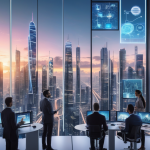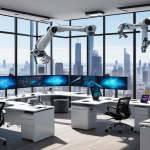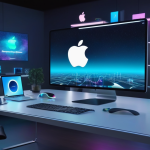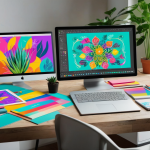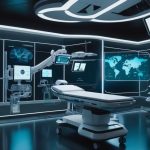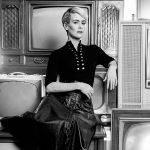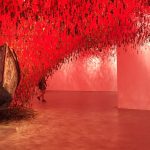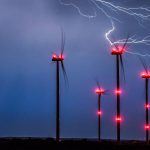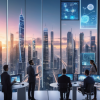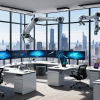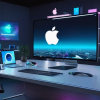Digital Art with AI: A New Era of Creativity
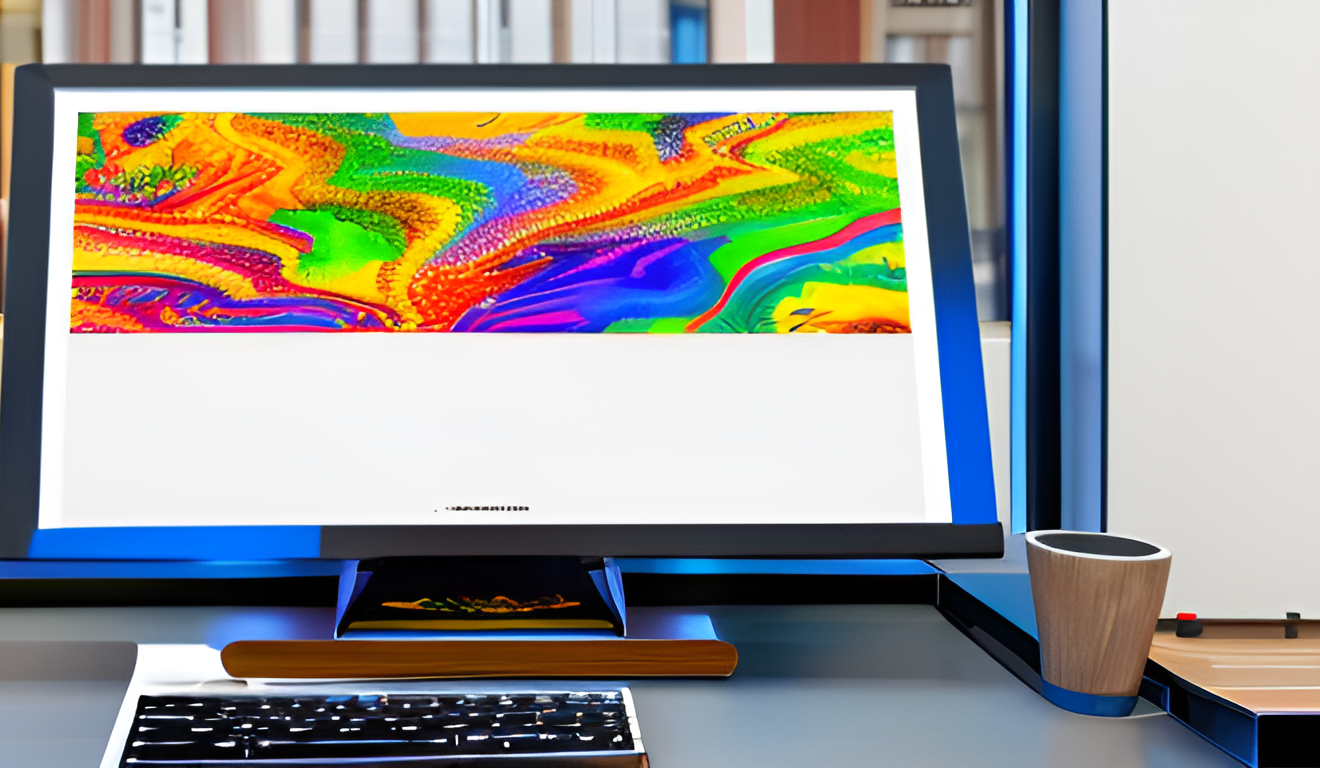
In today’s fast-paced world, the intersection of technology and creativity has birthed a revolutionary movement in the art scene: digital art powered by artificial intelligence. This new frontier not only challenges our perceptions of what art can be but also opens up a treasure trove of opportunities for artists and creators alike. Imagine a canvas where algorithms dance and paint in ways that the human hand could never replicate. Isn’t that fascinating?
As we dive deeper into this innovative realm, it’s essential to recognize how AI is reshaping the landscape of artistic expression. Artists are no longer confined to traditional mediums; they now wield an arsenal of digital tools that can generate stunning visuals, intriguing patterns, and even immersive experiences. With AI, the creative process transforms into a collaborative journey between human intuition and machine learning, resulting in art that is both unique and provocative.
Moreover, the emergence of AI in digital art raises thought-provoking questions about authorship and originality. Who is the true creator—the artist or the algorithm? This debate adds a layer of complexity to the art world, enticing both artists and audiences to rethink the very nature of creativity. As technology continues to advance, we can expect this dialogue to evolve, further enriching the art community.
In this new era, artists are encouraged to embrace change and explore the limitless possibilities that AI offers. The collaboration between human creativity and artificial intelligence is not just a trend; it represents a significant shift in how we perceive and create art. So, are you ready to join this exciting journey into the future of digital art?
The Rise of AI in Art
Artificial Intelligence is not just a buzzword anymore; it’s rapidly becoming a transformative force in the art world. Imagine a canvas where the brush strokes are dictated by algorithms, and the colors are selected by machine learning models. This is not a scene from a sci-fi movie; it’s the reality of AI in art today. Artists are now able to push boundaries that were previously unimaginable, exploring new creative avenues that blend technology with traditional artistry.
As AI technology continues to advance, it has opened the door to a plethora of innovative tools and techniques. Artists are no longer limited to their own skills and imagination. Instead, they can collaborate with AI systems to produce works that reflect a unique fusion of human creativity and machine precision. This synergy is not just about creating art; it’s about redefining what art can be. For instance, AI can analyze vast amounts of data to identify trends and styles that are resonating in the art community, allowing artists to stay ahead of the curve.
Moreover, the emergence of generative art—where algorithms create visual content—has become a game-changer. Artists can now create pieces that evolve over time or respond to viewer interactions. This dynamic quality adds a layer of engagement that traditional art forms often lack. The possibilities are endless, as artists experiment with different algorithms to produce stunning visuals that captivate audiences.
In this new era, the question arises: What does it mean to be an artist? Is it the creator of the algorithm, the artist who inputs the data, or the AI itself? As we delve deeper into this topic, it becomes clear that the role of the artist is evolving. With AI as a collaborator, artists are challenged to rethink their creative processes and what it means to create.
In conclusion, the rise of AI in art is not just a trend; it’s a revolution. It invites artists to embrace new technologies and explore uncharted territories in their creative journeys. As we move forward, the art world will undoubtedly continue to be shaped by these exciting advancements.
Understanding Generative Art
Generative art is a fascinating realm where creativity meets computation. At its core, this art form relies on algorithms to produce unique visual experiences that challenge the very notion of authorship. Imagine a canvas that evolves over time, where every brush stroke is dictated not by a human hand, but by a set of programmed rules. This innovative approach allows artists to explore new dimensions of creativity, pushing the boundaries of traditional art.
One of the most intriguing aspects of generative art is its ability to create infinite variations from a single algorithm. Just as a musician can compose countless melodies using a few notes, artists can generate an endless array of visuals using mathematical formulas. This intersection of mathematics and aesthetics not only redefines the creative process but also invites audiences to engage with art in a dynamic way. For instance, a single algorithm can produce different outputs depending on various parameters, such as color, shape, and size.
Moreover, generative art thrives on collaboration between artists and technology. Artists can input their creative vision into an algorithm, which then interprets and transforms it into a visual masterpiece. This collaboration opens up a world of possibilities, allowing artists to experiment with forms and patterns that may have been previously unimaginable. As we delve deeper into this artistic phenomenon, we uncover several key principles that define generative art:
- Algorithmic Design: The backbone of generative art, algorithms dictate how art is created.
- Interactivity: Many generative artworks engage viewers, allowing them to influence the outcome.
- Randomness and Control: Artists balance randomness with intentional design, creating unique results.
In summary, generative art is not just about creating visually appealing pieces; it’s about exploring the relationship between technology and creativity. As artists continue to experiment with algorithms, the future of generative art promises to be as exciting as it is unpredictable. This evolving landscape invites both artists and audiences to rethink what art can be and how it can be experienced.
Algorithms and Creativity
In the realm of digital art, algorithms are not just lines of code; they are the very foundation upon which new creative expressions are built. Imagine an artist standing before a blank canvas, but instead of paintbrushes, they wield algorithms that can generate intricate patterns, stunning visuals, and even entire compositions. This intersection of mathematics and aesthetics opens up a world where creativity knows no bounds.
At its core, generative art relies on algorithms to create unique pieces that can surprise both the artist and the viewer. These algorithms can be as simple as a set of rules guiding the placement of shapes or as complex as deep learning models that analyze vast datasets of existing art to produce something entirely new. The beauty lies in the unpredictability; artists often find themselves in a collaborative dance with their algorithms, where the output can lead to unexpected and delightful results.
To better understand how algorithms fuel creativity, consider the following key components:
- Randomness: Many generative algorithms incorporate elements of chance, allowing for spontaneous creativity that mimics the unpredictability of human thought.
- Parameters: Artists can set specific parameters that guide the algorithm, providing a framework while still leaving room for surprises.
- Feedback Loops: Some systems learn from previous outputs, refining their processes and leading to increasingly sophisticated creations over time.
The relationship between algorithms and creativity is not just about technology; it’s about rethinking what it means to be an artist in the digital age. As artists embrace these tools, they are challenged to redefine their roles, transforming from mere creators to orchestrators of complex systems that yield beautiful, thought-provoking art. This collaboration between human intuition and algorithmic precision is paving the way for a new era of artistic expression.
Types of Generative Algorithms
Generative algorithms are like the secret sauce of digital art, blending technology and creativity to produce stunning visuals. These algorithms can be categorized into several types, each offering unique artistic outcomes. Understanding these types can help artists choose the right tools for their creative endeavors.
One of the most popular types is procedural generation. This method uses predefined rules to create complex patterns and structures. Think of it as giving a chef a recipe; the chef can create a delicious dish, but the ingredients and method dictate the final outcome. Similarly, procedural generation allows artists to manipulate parameters to achieve different results, making it ideal for creating landscapes or intricate textures.
Another fascinating category is fractal algorithms. These algorithms are based on mathematical sets that exhibit a repeating pattern, regardless of the scale. Imagine zooming into a snowflake; no matter how close you look, it retains its intricate design. Fractals are perfect for creating visually captivating images that draw the viewer in, revealing new details at every level of zoom.
Additionally, we have evolutionary algorithms, which mimic the process of natural selection. Artists can generate a variety of designs, and through a process of selection, mutation, and crossover, the most appealing versions are chosen to evolve further. It’s like nurturing a garden where only the best flowers bloom, resulting in unique and unexpected artistic creations.
Lastly, neural networks have emerged as a powerful tool in generative art. These algorithms learn from vast datasets, enabling them to create art that reflects various styles and influences. They can produce everything from abstract pieces to realistic portraits. By training a neural network on a diverse range of artworks, artists can explore new creative horizons, blending their vision with the machine’s capabilities.
In summary, the world of generative algorithms is rich and diverse. By exploring procedural generation, fractal algorithms, evolutionary algorithms, and neural networks, artists can push the boundaries of their creativity. The fusion of technology and art not only enhances the creative process but also opens up endless possibilities for innovation in digital art.
Collaborative AI Art Projects
In the ever-evolving landscape of digital art, are emerging as a groundbreaking phenomenon. These projects bring together the creative minds of artists and the analytical prowess of artificial intelligence, resulting in unique and thought-provoking artworks. Imagine a painter working alongside an AI that can analyze thousands of art styles in seconds; the possibilities are truly exhilarating!
One of the most notable examples is the collaboration between artists and the AI program DeepArt. This platform uses deep learning algorithms to transform photographs into stunning pieces of art, mimicking the styles of famous painters like Van Gogh and Picasso. Artists can experiment with their own works, enhancing them with AI-generated styles, creating a fusion of human creativity and machine learning.
Moreover, collaborative projects often lead to discussions about the nature of creativity itself. When an AI contributes to the artistic process, questions arise: Who is the true creator? Is it the human artist, the machine, or a combination of both? These discussions deepen our understanding of art and challenge traditional notions of authorship.
Here are a few notable collaborative AI art projects that have made waves in the art community:
- Obvious: This Paris-based art collective created the AI-generated portrait “Edmond de Belamy,” which sold for a staggering $432,500 at auction, sparking debates about originality.
- Refik Anadol: Anadol’s installations use AI to create immersive experiences, blending data and art in a way that captivates audiences.
- AI Artists: Various platforms allow multiple artists to collaborate with AI, exploring themes of identity and technology through their joint efforts.
Collaborative AI art projects not only push the boundaries of creativity but also foster a sense of community among artists and technologists. As these partnerships continue to grow, they promise to reshape the future of art, inspiring new forms of expression and engagement.
The Role of Machine Learning
Machine learning is like the secret sauce that makes artificial intelligence truly shine in the world of digital art. Imagine having a smart assistant that learns from every brushstroke, every color choice, and every creative decision you make. That’s precisely what machine learning does! By analyzing vast datasets of existing artworks, it empowers AI to understand styles, techniques, and even the emotional nuances behind different pieces. This capability opens up a realm of possibilities for artists, allowing them to push the boundaries of their creativity.
At its core, machine learning operates through complex algorithms that can identify patterns and trends within data. For artists, this means:
- Personalized Art Creation: Artists can train AI models on their own unique styles, enabling the generation of artwork that resonates with their vision.
- Enhanced Creativity: By suggesting new combinations and styles, machine learning can inspire artists to explore uncharted territories.
- Efficiency: Automating repetitive tasks allows artists to focus on the more exciting aspects of their work, leading to a more fulfilling creative process.
Moreover, machine learning isn’t just about creating art; it’s also about understanding it. Through sentiment analysis and visual recognition, AI can interpret the emotional weight of a piece, helping artists and audiences alike to connect on a deeper level. This intersection of technology and creativity is not only fascinating but also transformative, as it encourages a dialogue about what art can be in the digital age.
As we continue to witness advancements in machine learning, the potential for AI to shape the future of digital art becomes increasingly evident. Artists who embrace these technologies will find themselves at the forefront of a revolution, crafting works that are not only innovative but also deeply personal. The question remains: how will you leverage machine learning to redefine your artistic journey?
AI Tools for Artists
In today’s rapidly evolving digital landscape, AI tools have become indispensable for artists looking to push the boundaries of creativity. These innovative technologies not only streamline the creative process but also open up a world of possibilities that were previously unimaginable. Imagine having a virtual assistant that can analyze your style, suggest modifications, and even generate new ideas based on your previous works. Sounds like a dream, right? Well, this is the reality that many artists are embracing.
Among the plethora of AI tools available, several stand out for their unique functionalities. For instance, software like DeepArt and Artbreeder leverage deep learning algorithms to transform ordinary images into stunning artworks. They allow artists to manipulate styles and create entirely new pieces by blending different artistic influences. This is akin to having an endless canvas where the only limit is your imagination.
Moreover, AI-assisted design platforms such as Runway ML and Adobe Sensei are revolutionizing the way artists approach their projects. These platforms not only enhance creative workflows but also provide tools that can automate repetitive tasks, freeing up valuable time for artists to focus on what truly matters—creation. With features like image recognition and content-aware fill, artists can achieve results that were once labor-intensive, in just a few clicks.
To give you a clearer picture, here’s a brief overview of some popular AI tools:
| Tool Name | Functionality |
|---|---|
| DeepArt | Transforms photos into artworks using neural networks. |
| Artbreeder | Generates new images by blending existing artworks. |
| Runway ML | Offers a suite of AI tools for video and image editing. |
| Adobe Sensei | Enhances Adobe’s suite with AI-driven features for design. |
As we can see, the integration of AI tools into the artistic process is not just a trend; it’s a transformative movement that empowers artists to explore new dimensions of creativity. Whether you’re a seasoned professional or just starting, these tools can help you elevate your work to new heights. So, why not dive in and see how AI can enhance your artistic journey?
Software for Generative Art
In the realm of generative art, the right software can be a game changer for artists looking to push the boundaries of their creativity. With a plethora of options available, artists can harness the power of algorithms to create stunning visuals that were once unimaginable. But what makes this software so special? It’s all about the unique features and functionalities that cater specifically to generative art.
One of the standout tools in this field is Processing, an open-source software sketchbook and language for learning how to code within the context of the visual arts. It allows artists to create dynamic visuals with ease, making it a favorite among both beginners and seasoned professionals. Another noteworthy mention is TouchDesigner, which is widely used for interactive multimedia content. Its visual programming interface enables artists to manipulate data in real-time, offering a hands-on approach to generative art.
Additionally, p5.js is gaining traction among digital artists. This JavaScript library simplifies the process of coding for artists, allowing them to create graphics and interactive content for the web. The community around p5.js is vibrant and supportive, making it an excellent choice for those new to the field.
Here’s a quick comparison of some popular software for generative art:
| Software | Key Features | Best For |
|---|---|---|
| Processing | Open-source, Visual arts coding | Beginners & Professionals |
| TouchDesigner | Real-time interactive visuals | Interactive multimedia artists |
| p5.js | JavaScript library for web graphics | Web-based artists |
These tools not only empower artists to explore their creativity but also foster a collaborative environment where ideas can flourish. As technology continues to evolve, the capabilities of generative art software will only expand, allowing for even more innovative creations. So, if you’re an artist looking to dive into the world of generative art, embracing these software platforms could be your first step toward a vibrant new artistic journey!
AI-Assisted Design Platforms
In the ever-evolving world of digital art, are revolutionizing the creative process. These innovative tools leverage the power of artificial intelligence to assist artists in generating unique designs, streamlining workflows, and enhancing overall creativity. Imagine having a partner that not only understands your artistic vision but also suggests ways to elevate it—this is the promise of AI in design.
One of the most exciting aspects of these platforms is their ability to analyze vast amounts of data and learn from it. By utilizing machine learning algorithms, these tools can recognize patterns, styles, and trends, allowing artists to explore new territories in their work. For instance, platforms like DeepArt and RunwayML enable users to transform their images into stunning pieces of art by applying various artistic styles. This not only saves time but also inspires artists to experiment with different aesthetics.
Moreover, AI-assisted design platforms often come equipped with features that facilitate collaboration. Artists can share their creations in real-time with peers or even with AI systems, fostering a dynamic environment for feedback and improvement. This collaborative spirit not only enhances the creative process but also builds a community of innovators pushing the boundaries of digital art.
To give you a clearer picture, here’s a quick overview of some popular AI-assisted design platforms:
| Platform | Features |
|---|---|
| DeepArt | Style transfer, image enhancement, user-friendly interface |
| RunwayML | Real-time collaboration, various AI models, video editing |
| Artbreeder | Image blending, genetic algorithms, community sharing |
In conclusion, AI-assisted design platforms are not just tools; they are gateways to new forms of artistic expression. By integrating AI into their workflows, artists can unlock an array of creative possibilities that were previously unimaginable. As we embrace these technologies, the future of digital art looks brighter than ever.
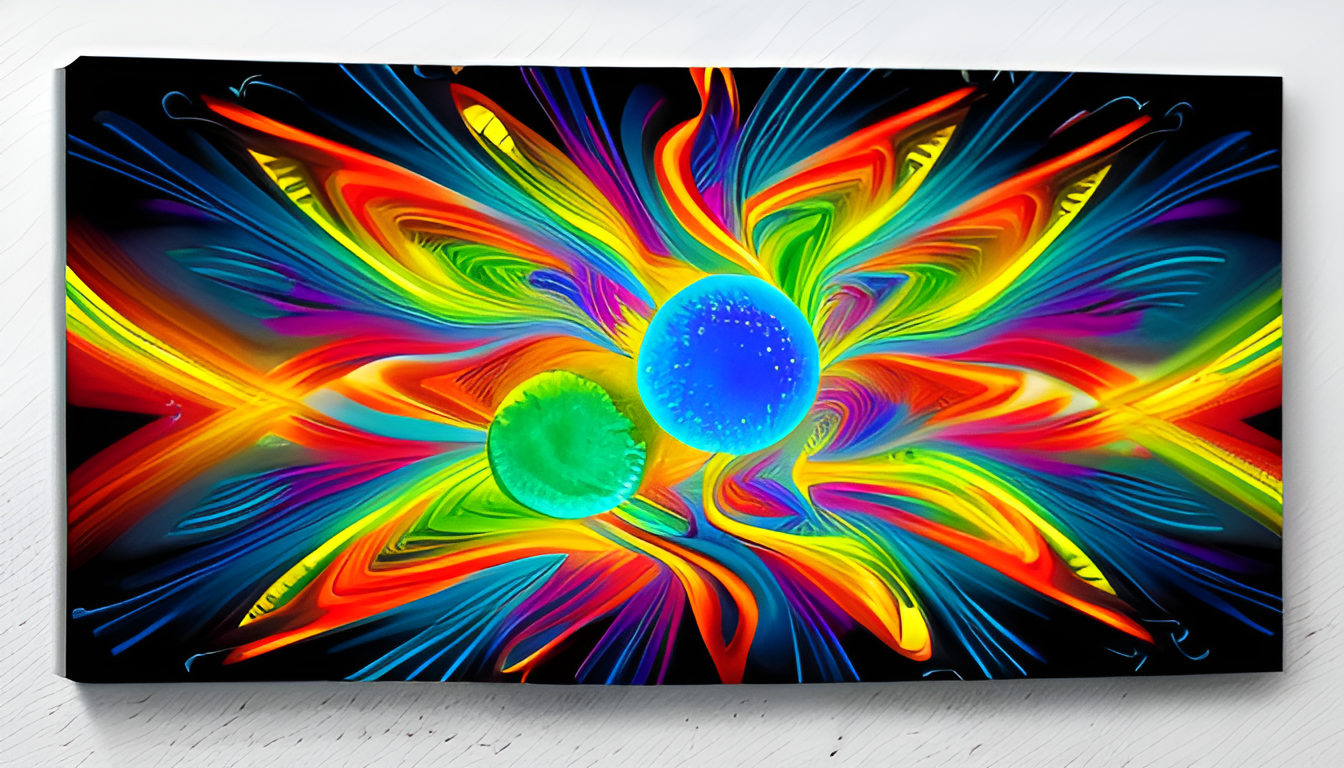
The Ethical Implications of AI Art
As we dive deeper into the realm of digital art created with artificial intelligence, we stumble upon a maze of ethical considerations that artists and audiences alike must navigate. The rise of AI-generated art is not just a technological marvel; it raises profound questions about authorship, originality, and the very essence of creativity itself. Can a machine truly create art, or is it merely a reflection of the data fed into it?
One of the most pressing issues is the question of authorship. When a piece of art is generated by an AI, who is the true creator? Is it the programmer who designed the algorithm, the artist who provided the initial concept, or the AI itself? This ambiguity can lead to disputes over copyright and ownership, complicating the landscape for artists who rely on AI tools. For instance, if an AI generates a stunning piece based on thousands of existing artworks, does it infringe on the rights of those original artists?
Furthermore, the concept of originality is challenged in this new era of art. Traditional definitions of originality revolve around the unique expression of an individual artist. However, with AI’s ability to remix and recombine existing styles and techniques, the line between original art and derivative works becomes increasingly blurred. This raises the question: should AI-generated art be considered a collaboration rather than a standalone creation?
To further illustrate these points, consider the following table that outlines key ethical concerns surrounding AI art:
| Ethical Concern | Description |
|---|---|
| Authorship | Who owns the rights to AI-generated art? |
| Originality | Is AI art truly original or just a remix of existing works? |
| Creativity | Can machines possess creativity, or is it a human trait? |
| Impact on Artists | How does AI art affect the livelihoods of traditional artists? |
As we continue to embrace AI in the art world, these ethical implications will require thoughtful discussion and consideration. The balance between innovation and respect for traditional artistry is delicate, and it is up to the community to navigate these waters with care. After all, art has always been a reflection of society, and as technology evolves, so too must our understanding of what it means to create.
The Future of AI in Digital Art
The future of AI in digital art is not just bright; it’s positively dazzling! As technology continues to evolve at breakneck speed, artists and technologists alike are discovering new ways to push the boundaries of creativity. Imagine a world where artistic expression is limited only by one’s imagination, rather than by traditional tools or techniques. This is the exciting potential that AI brings to the table.
One of the most thrilling aspects of this evolution is the integration of augmented reality (AR) and virtual reality (VR) with AI-generated art. These technologies allow artists to create immersive experiences that engage audiences on a whole new level. Picture walking through a digital gallery where the art changes based on your emotions or even your movements. This level of interactivity could redefine how we experience art!
Moreover, as AI continues to learn and adapt, we can expect to see even more sophisticated tools that assist artists in ways we can only dream of today. For example, imagine an AI that not only suggests color palettes but also understands the emotional undertones of a piece and offers adjustments to enhance its impact. This kind of collaboration could lead to an explosion of creativity, where artists are empowered to explore uncharted territories.
Of course, with great power comes great responsibility. As we embrace these technological advancements, it’s crucial to consider the ethical implications. Questions regarding authorship, originality, and the value of human creativity will be at the forefront of discussions in the art community. How do we define an artist when machines can create alongside them? These are the conversations we need to have as we move forward.
In summary, the future of AI in digital art is a thrilling frontier filled with possibilities. As we stand on the cusp of this new era, the fusion of technology and creativity promises to transform not just how art is made, but how it is experienced and appreciated. The canvas of tomorrow is waiting for us, and it’s going to be a masterpiece!
Conclusion: Embracing Change
As we stand on the brink of a new era in the world of digital art, it is clear that embracing AI technology is not just an option, but a necessity for artists who wish to thrive. The integration of artificial intelligence into the creative process has opened up a plethora of opportunities, allowing artists to push the boundaries of their imagination. Just like a painter who discovers a new color, artists today can explore uncharted territories in their work thanks to AI.
However, this shift comes with its own set of challenges. Questions about authorship, originality, and the ethical implications of using AI in art are becoming increasingly relevant. Artists must navigate these waters carefully, ensuring that their unique voice is not lost in the algorithms. It’s a little like learning to dance with a partner; you have to find the right balance between leading and following.
Looking ahead, the future of AI in digital art is not just about technology; it’s about the collaboration between human creativity and machine learning. As artists continue to adapt to these changes, they will find that AI can be a powerful ally in their creative journey. The fusion of human intuition and machine efficiency could lead to stunning innovations that we can’t even imagine yet.
In conclusion, the art world is evolving, and those who embrace this change will find themselves at the forefront of a vibrant and dynamic landscape. As we continue to explore the intersection of art and technology, it’s essential to keep an open mind and a curious spirit. The future holds exciting possibilities, and the journey is just beginning. Will you be part of this revolution?
Frequently Asked Questions
- What is AI-generated art?
AI-generated art is artwork created with the assistance of artificial intelligence algorithms. These algorithms can analyze vast amounts of data and generate unique designs, allowing artists to explore new creative possibilities.
- How does generative art differ from traditional art?
Generative art relies on algorithms to create pieces, often resulting in unpredictable outcomes. Traditional art, on the other hand, is typically created through direct human intervention, where the artist has full control over the process and final product.
- What tools are available for artists using AI?
There are numerous AI tools available, including software for generative art and AI-assisted design platforms. These tools help streamline the creative process and expand artistic possibilities, allowing artists to innovate like never before.
- Are there ethical concerns surrounding AI art?
Yes, the rise of AI in art raises important ethical questions about authorship and originality. Artists must navigate these moral considerations as they incorporate AI into their creative practices.
- What does the future hold for AI in digital art?
The future of AI in digital art looks bright, with ongoing advancements promising to shape new trends and innovations. As technology evolves, artists can expect to see even more exciting tools and opportunities emerge in this dynamic field.
